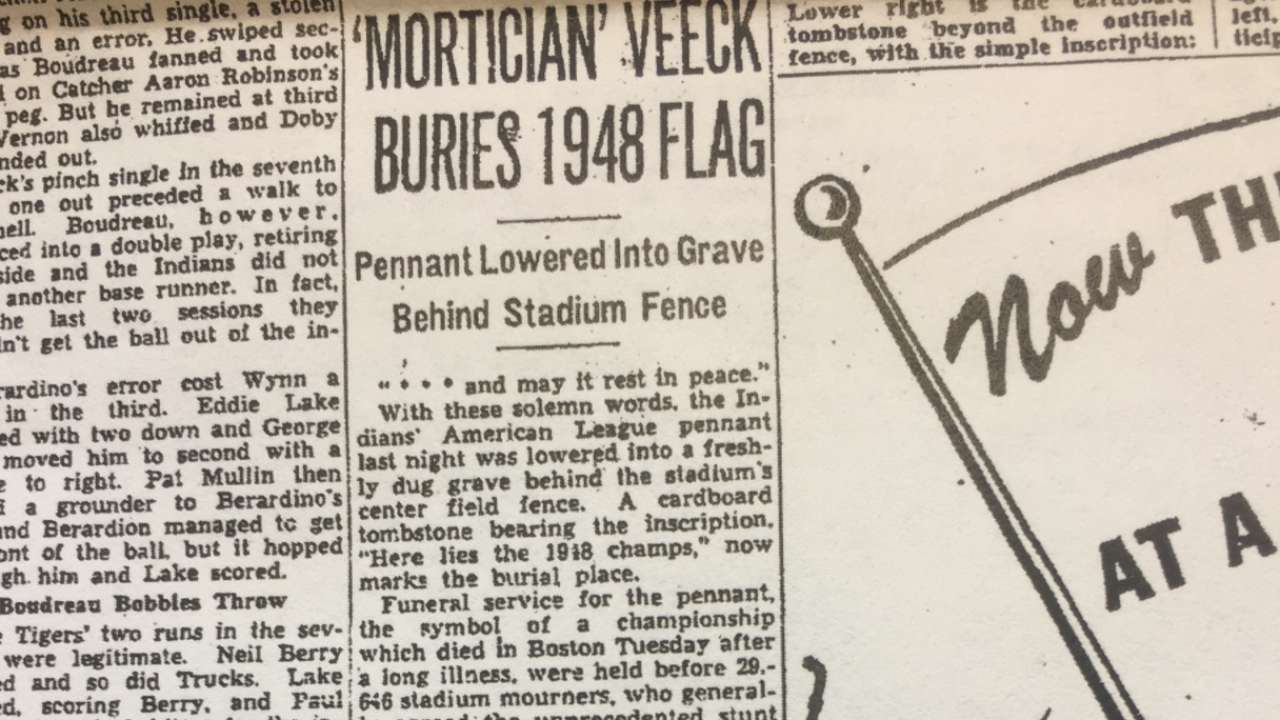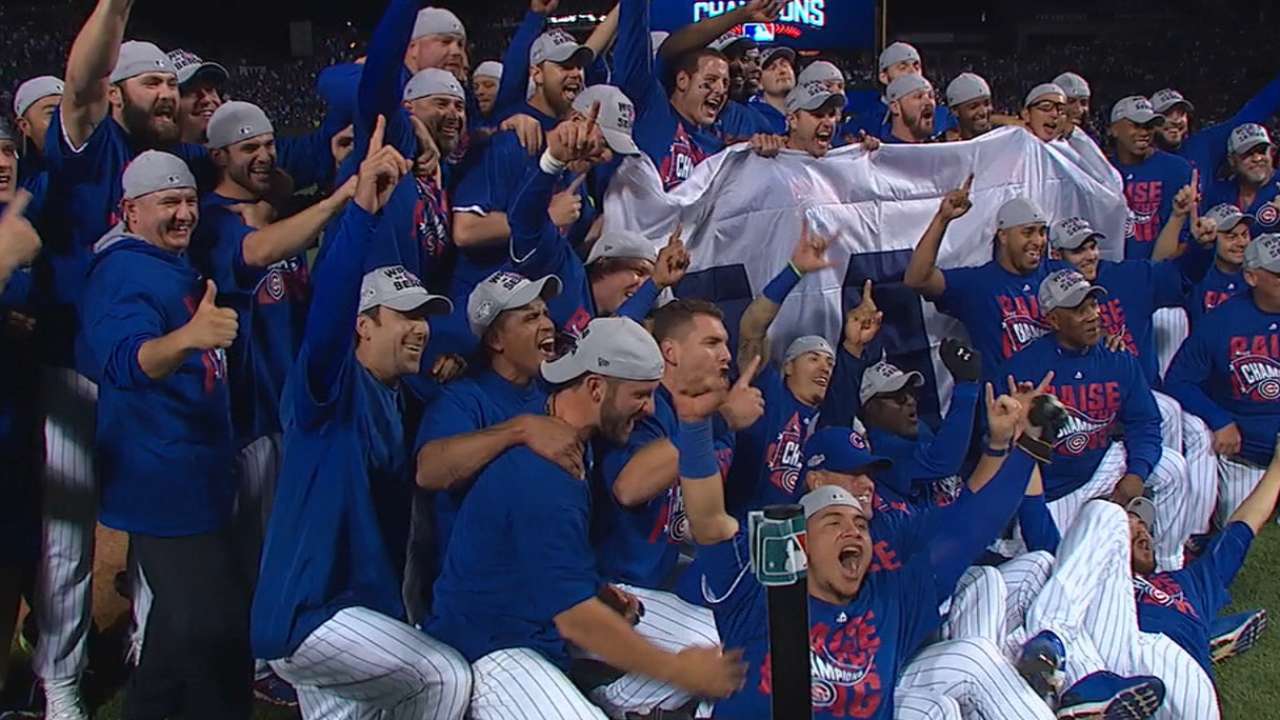Legend of missing '48 pennant 2:15
Indians curator Jeremy Feador discusses how the club's 1948 World Series pennant went missing after a "burial" ceremony in 1949
Whereabouts of Tribe's '48 title pennant remains a mystery
Physical symbol of Cleveland's last World Series win has not been seen for 67 years
By Anthony Castrovince / MLB.com | @castrovince | 5:30 PM ET + 1 COMMENT
CLEVELAND --
It once flapped in the breeze above old Municipal Stadium, a physical representation of a triumphant World Series title that, for the past 68 years, the Indians have fought futilely to reclaim. Our best guess is that it was upwards of 15 feet wide, a broad banner broadcasting Cleveland's clout to any and all. And because the importance of that 1948 outcome has only grown in measure with each successive season that has led to this 2016 return to the Fall Classic stage, you could say the importance of this pennant has only grown in importance, too.
Now, if only we knew where the heck it is.
Win a World Series in the year 2016, as the American League champs hope to do sometime in the next week and a half, and you get the stunning sterling-silver trophy, designed by Tiffany & Co., that features flags representing each of Major League Baseball's 30 clubs.
But back in 1948, the year the Tribe last won it all, no such trophy existed. And so, it was a physical flag -- a proper pennant -- that stood as the symbol of unmatched success. It featured a backward image of Chief Wahoo, with his eyes looking up at the crown on his head, and the phrase, "1948 WORLD CHAMPION CLEVELAND INDIANS." It wasn't fancy, but it was seemingly finite.
Alas, it's been 68 years since the Indians claimed that pennant and 67 years since the thing was last seen in public.
"It's kind of gotten built up [among] the people who are deeply invested in the history," team curator Jeremy Feador said. "If you're a casual fan, you're probably like, 'Oh, cool, a pennant, whatever.' But if you're a real baseball nerd, yeah, it's one of those unique stories."
The 1948 Indians were, like many champions before or since, a pretty good story.
It was shortstop/manager Lou Boudreau's career year (he struck out just nine times in 676 plate appearances). It was Gene Bearden's unfortunately unsustainable rookie year (20 wins and a league-best 2.43 ERA, marks he'd never again come close to matching). It was a year in which Bob Feller battled back issues but turned in some strong and necessary September success.
And it was also a year in which the Indians prevailed in a classic late-season race with the Red Sox and Yankees. The Tribe was four games behind Boston with 23 to play, but rallied in time to force an unprecedented tiebreaker on Oct. 4 at Fenway Park, with Bearden, pitching on one day's rest, turning in nine strong innings to lead the way.
"In those days," Bearden said in 1998, "we didn't need four or five days' rest like they do today. We didn't count pitches; we counted outs."
Gene Bearden is carried off the field by teammates after beating the Boston Red Sox in a tiebreaker to claim the 1948 American League pennant. (AP)
The outs -- and the wins -- kept coming in the World Series against the Boston Braves. The Indians lost Game 1, in part because of a controversial call on Feller's pickoff attempt on Phil Masi at second base ("About 50 million people [watching the first coast-to-coast broadcast of a World Series game] called him out," Feller would say in 2008, "but one guy called him safe, and he was 10 feet away"). They would, however, win Games 2, 3 and 4. Though the chance to clinch in front of a then-record 86,288 fans at Municipal Stadium was foiled, the Indians went back to Boston to win Game 6 and set off a raucous celebration on their train ride home.
When railroad officials complained about the state of the train upon its arrival in Cleveland, owner Bill Veeck told them, "Don't worry, we'll buy you a new one."
That was Veeck, flamboyant as could be.
And that leads us back to the mystery of the '48 pennant.
On Sept. 24, 1949, with the Indians having been disappointingly eliminated from contention in the AL chase, a notice was published in the Cleveland Plain Dealer:
"Unusual ceremonies will precede the Indians' game with the Detroit Tigers tonight at the stadium and fans are urged to be in their seats by 8 and ready to take part in the fun."
As it turned out, Veeck put the "fun" in funeral.
If you're going to go down, he figured, you might as well go down laughing.
With the ceremonies underway, Veeck, dressed as a mortician, sat atop a horse-drawn hearse of a late-1800s vintage while carrying a copy of the Sporting News (because baseball people referred to it as their "Bible"). Boudreau, his coaches and other team personnel served as pallbearers. A band played a funeral dirge, with the procession moving toward the center-field flagpole, where the pennant was lowered and placed in a pine coffin. The pallbearers put the pennant in a hearse, and the hearse made a circle around the playing field, with the Indians' players joining in the procession when it reached the home dugout. Finally, the coffin was lowered into a grave just beyond the outfield wall, marked by a tombstone with the inscription, "1948 CHAMPS."
The colorful Bill Veeck was the owner of the Indians when they won the 1948 World Series. (AP)
And that, unfortunately, is the extent of what we know of the whereabouts of the '48 pennant.
"It's bizarre," Feador said. "After that, you [didn't] hear anything about it. Did someone dig it up after the game? Did it stay there? No one really knows. The legend is just quiet after that."
Perhaps, the pennant was never exhumed. Maybe it sat in that grave for going on five decades, was unintentionally excavated during the Municipal Stadium demolition in 1996 and was somehow not spotted as it was dumped into the Lake Erie waters along with the pieces of the building that became a fish habitat.
But this theory seems rather -- ahem -- fishy. One figures a coffin -- especially one not likely to have been buried all that deep in the dirt -- would have been easy to spot during such a process, if in fact it even survived the myriad remodeling projects that took place in and around the baseball and football fields over the building's long history.
So maybe the pennant was unearthed. Maybe some team employee laid claim to it and took it home, stuck it in storage and forgot all about it, then sold the home to somebody who sold it again.
Maybe you, reading this, right this very second on your smartphone in the suburbs, are sitting on a couch in a living room in a house with a crawlspace that contains the only physical embodiment of the Tribe's last title.
And hey, maybe there's a T206 Honus Wagner card down there, too!
Go ahead and keep an eye out for the pennant, but there are absolutely no clues as to its whereabouts.
It's possible, though unproven, that the pennant was again accounted for at Municipal sometime after '49.
In 1951, the Indians became the first team to open a museum at their home park. The shrine featured such artifacts as a Nap Lajoie bat, the ball from Bill Wambsganss' historic unassisted triple play in the 1920 World Series and the bat Elmer Smith used to hit the first World Series grand slam, also in '20. It remained operational -- and free of charge -- in the stadium's lower concourse near Section 11 until '72, when attendance nose-dived. But while the National Baseball Hall of Fame has records of the Indians sending some items from their Hall to the actual Hall, many of the treasures that were known to be on display have simply vanished.
"A lot of these things just went missing after the museum closed," Feador said. "I'm not sure if there is any correlation between that and the pennant."
People will contact Feador, attempting to get the Indians to buy various artifacts, almost invariably (and a little too conveniently) from the club's only championship seasons in 1920 and '48, when MLB did not have the authentication process it has today. One guy did call about a large pennant that, he claimed, was flown over the '48 World Series. But he sent Feador a photo, and it was not a match of the pennant in question. There are rings from that '48 Series in circulation, and the Hall of Fame has bases from it. But the pennant remains the Lost Ark of the Tribe's last title.
Bob Lemon, Gene Bearden and Jim Hegan celebrate the Indians' victory over the Boston Braves in the 1948 World Series. (AP)
"It wasn't like this big flag got thrown in the dumpster and now it's gone," Feador said. "No, there was this elaborate event, and clearly there was symbolism attached to it. So to be able to find that, I think, would be neat, because it's one of those cool, tangible reminders of the past."
Unless somebody really did stop reading this, crept into a crawl space and pulled out the pennant, odds are it'll never be uncovered. It's in that undiscoverable, indescribable void in which the treasures of Lima or Montezuma or Blackbeard's ill-gotten gains all reside, never to be reclaimed.
So while we can cite the season, we can talk about Boudreau and Bearden, we can look up old photos of Feller, we simply can't see and can't touch the material reminder of the last time the Indians won it all.
All the more reason for them to do it again this year.








